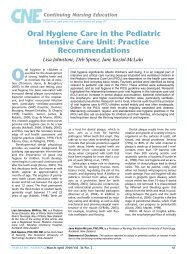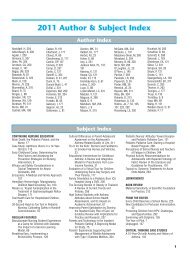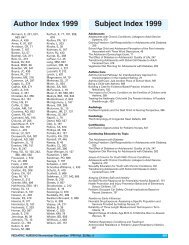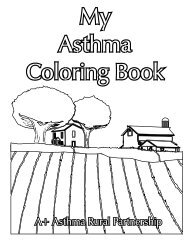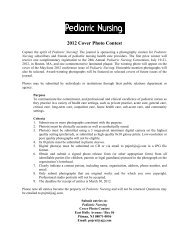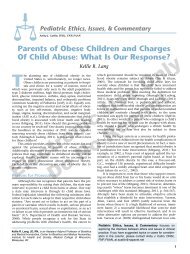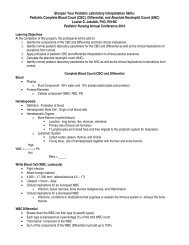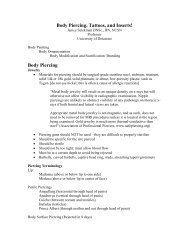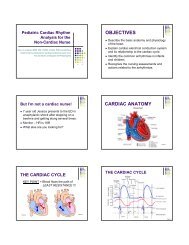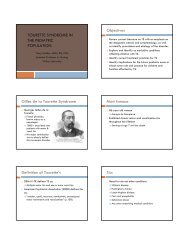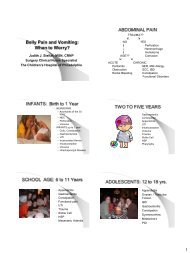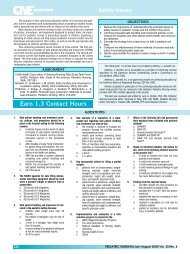Jannetti Publications Guidelines For Authors - Pediatric Nursing
Jannetti Publications Guidelines For Authors - Pediatric Nursing
Jannetti Publications Guidelines For Authors - Pediatric Nursing
Create successful ePaper yourself
Turn your PDF publications into a flip-book with our unique Google optimized e-Paper software.
II. MANUSCRIPT PREPARATION AND ORGANIZATION**<br />
A. Subject<br />
1. Select a subject that interests you.<br />
2. Know your subject.<br />
3. Research those areas you are unsure about;<br />
make notes as you do this; and interview (ask<br />
questions) if necessary. Review the literature<br />
to see whether the subject you’re interested in<br />
has already been “overwritten.” Even if your<br />
subject has been well covered in the literature,<br />
it may be of interest to others if it offers<br />
a new approach to an old problem.<br />
B. Outline<br />
Make an outline according to the following:<br />
1. List all the ideas, arguments, facts, and illustrations<br />
you can think of. Establish the what,<br />
where, when, why, how, and who for your<br />
lead paragraphs.<br />
2. Sort out these ideas, putting them in logical<br />
order for continuity.<br />
3. Fully develop each idea in an orderly fashion.<br />
4. Insert anecdotes and cite examples where<br />
appropriate.<br />
5. Come to a logical conclusion. Leave readers<br />
with the idea that they can reach their own<br />
conclusions based on the material you have<br />
presented. (Exceptions: The “human interest”<br />
story where an incident you’ve experienced<br />
probably won’t be repeated again; a<br />
philosophic piece.)<br />
C. Start Writing<br />
1. Select a suitable time of day and a comfortable<br />
location.<br />
2. Your lead must be focused — it should draw<br />
readers in and motivate them to read further.<br />
Read some leads in your favorite newspaper,<br />
lay magazine, or professional journal. The<br />
lead should be fairly brief, but don’t forget<br />
the what, where, when, why, how, and who.<br />
3. Don’t let grammar, spelling, punctuation, or<br />
construction interrupt your thoughts and<br />
ideas. On your first draft, just write! Avoid<br />
excessive editing while you are writing; that<br />
can be confusing and you’ll probably do<br />
quite a bit of revising later.<br />
D. First Draft<br />
1. It can be very effective to put the manuscript<br />
aside and go over it after some time has<br />
elapsed (overnight, a few days, or a week).<br />
8<br />
2. Examine the paper for grammar, construction,<br />
spelling, punctuation, and so on. Does it<br />
flow well? Do ideas logically follow one<br />
another? Does your story make sense? Do<br />
the beginning, body, and ending make sense<br />
to you?<br />
3. Read it aloud to someone — or even to yourself.<br />
But read it aloud.<br />
E. Titling<br />
1. Begin to think of a title. Remember: long<br />
titles are hard to handle.<br />
2. Make sure the title clearly and succinctly<br />
describes the manuscript’s contents.<br />
F. Miscellaneous Points<br />
1. Avoid injecting your own biases.<br />
2. If you are stumped on a lead paragraph, start<br />
writing anyway. The idea may come as you<br />
write, and the lead can then be reworked. It<br />
may also help to tell someone what your article<br />
is about. We often organize things spontaneously<br />
when describing something aloud,<br />
and the lead is usually the first and most<br />
important point you try to convey.<br />
3. Make sure your conclusion ends your<br />
thoughts. Don’t leave your reader dangling.<br />
4. Make sure you use transitional phrases where<br />
necessary. That is, don’t jump from one subject<br />
to another without leading the reader into<br />
the next thought.<br />
5. Use the active voice when possible (see “Verb<br />
Checklist,” p. 10).<br />
6. Examples (anecdotes) enhance any article.<br />
7. Avoid jargon and qualifiers (“a little,” “very,”<br />
and so on); they muddy the water.<br />
8. Watch for omnipotent words (“unique,”<br />
“only,” “every,” “none”). Ninety-nine out of a<br />
hundred times you’ll be wrong.<br />
9. Check your stylebook(s) for correct methods<br />
when using numbers, capitals, formal names,<br />
and so on.<br />
10. Avoid using the word “impact” as a verb,<br />
when what you really mean is affect or effect.<br />
Example of incorrect usage: “The results of the<br />
study impacted the staff.” As a noun, impact<br />
means “The effect or impression of one thing<br />
upon another.” As a verb, it means “to pack<br />
firmly together” or “to strike forcefully.”<br />
**(Source: Alice M. Robinson, MS, RN, Writing Workshop)



